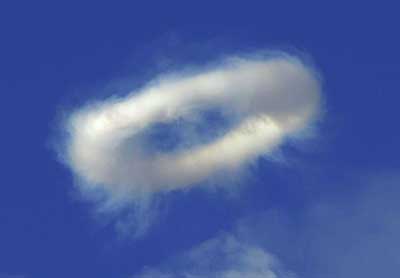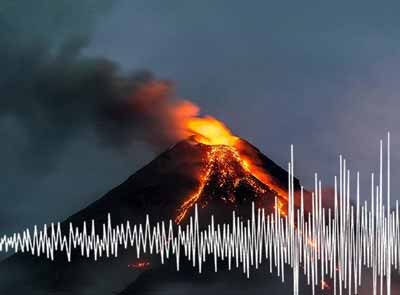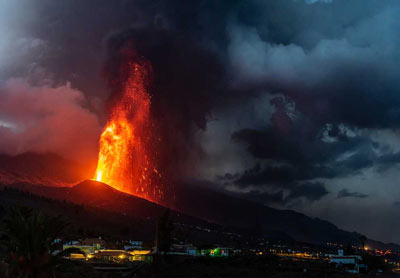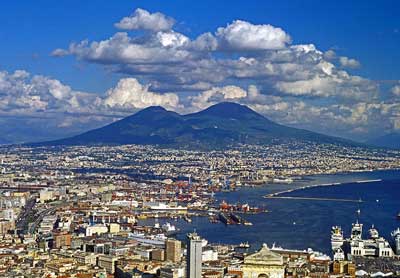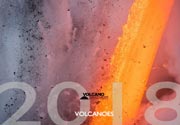New lava flow from SE crater
Update Wed 19 Apr 2017 16:23

Etna's new lava flow from the SE cone seen on the thermal webcam of INGV Catania on Montagnola
After a pause of 4 days, a new (mainly effusive) eruptive episode started this morning around 11:30 local time. Accompanied by mild strombolian activity from the summit vent of the SE crater cone, a new lava flow began to descend on the southern flank of the SE crater complex.
It follows and partially overlaps the previous lava flows from 10-11 and 13-15 April in direction of the western rim of the Valle del Bove.
New eruptive (largely effusive) episode
Update Fri 14 Apr 2017 09:50
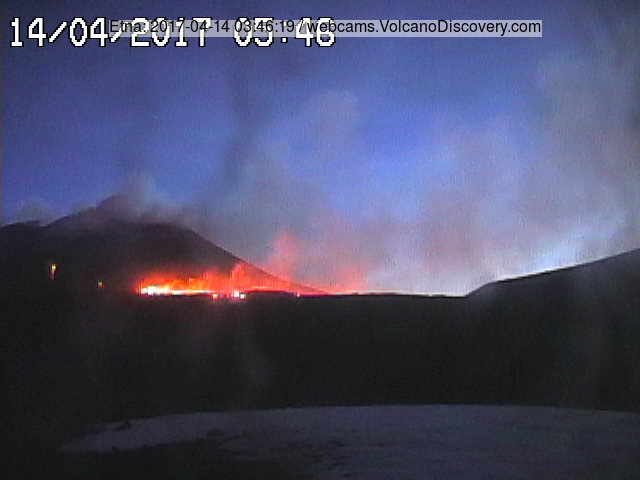
Etna's lava flow this morning (Radiostudio 7 webcam from Montagnola)

Strombolian activity at the summit vent of the SE cone

Beginning of lava effusion from both the summit vent and the opening vent at the southern base shortly after
After 48 hours of pause since the previous, short-lived eruptive episode, a new effusive eruptive phase began last evening, involving 3 vents.
Tremor started to rise from 20:00 local time; strong glow started to appear at the summit vent of the new SE cone (on top of the SE crater complex) shortly after 22:00 local time, suggesting the time when new magma had arrived near the surface. A phase of weak strombolian-type explosions followed from this vent.
Starting at 22:27, lava flows appeared: probably first from the summit vent, but immediately followed by the opening and stronger lava effusion from the vent at the southern base of the crater complex (which had been the site of the previous eruptions in March and early April).
It seems that shortly after, a third effusive vent opened about half way between the other two vents on the upper slope of the SE crater complex, also feeding a lava flow.
While the two lava flows from the higher vents stopped during the night, the one from the lower vent continued to travel towards the east and reached the Valle del Bove slope from around 4:00 am (local time) at night. As of this morning, this lava flow was still active.
Time-lapse video:
Short-lived eruptive phase during 10-11 April

Etna's lava flows in the evening of 10 April (photo: Alessandro Lo Piccolo / facebook)
After a brief pause of 2 days, the effusive vent at the base of the SE crater complex opened up again in the afternoon of 10 April, feeding a new lava flow that traveled east, formed several closely spaced branches and quickly reached the upper slopes of the Valle del Bove.
By the morning of 11 April, all eruptive activity had ceased again.
New images of lava flow, but activity decreases
Update Sun 09 Apr 2017 17:55
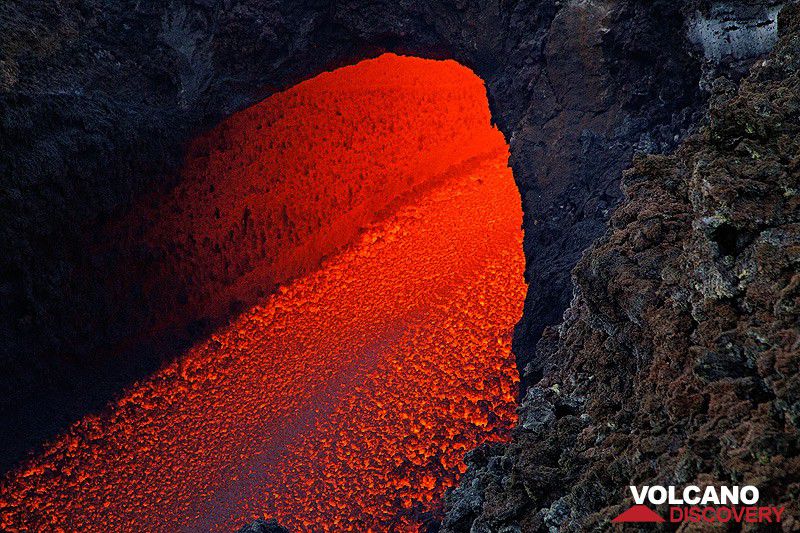
Etna's lava flow on 7 April 2017 (photo: Emanuela / VolcanoDiscovery Italy)
The lava flow effusion seems to have decreased strongly or stopped over night. Dough and Emanuela who climbed the area of the vent yesterday afternoon were lucky to still see beautiful activity with lava flowing inside the main channel near the vent. [link to photos]
In its upper portion below the effusive vent at about 2900 m elevation at the southern base of the SE crater complex, the lava flow was entirely underground inside a tube, but exited at a so-called ephemeral vent a few 100 m downslope into an open channel feeding an active 'a'a-type lava flow.
Further downslope, small lava fronts high on Etna's southwestern flank have also been seen by other observers. However, it seems that for now, Etna's most recent eruptive phase might have ended; for how long Etna will remain calm is a matter of guessing.
Lava flow from new fissure vent continues
Update Sun 02 Apr 2017 16:13
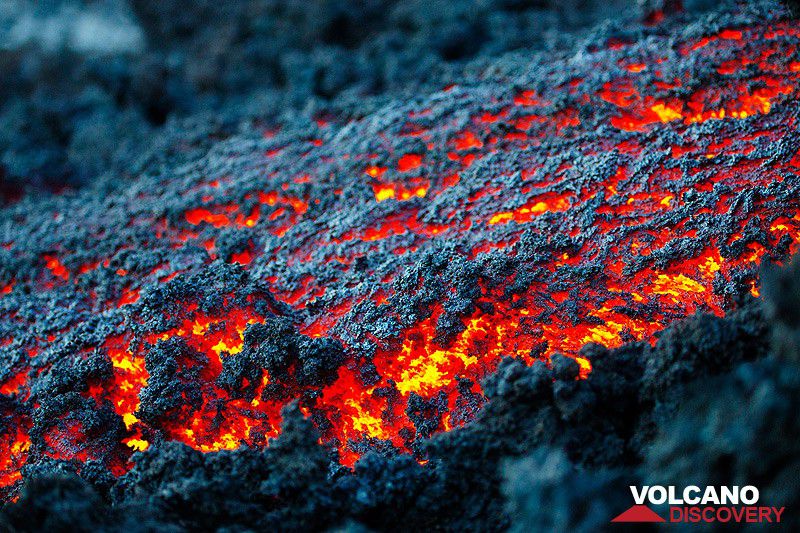
Etna's lava flow on 30 March 2017 (photo: Emanuela / VolcanoDiscovery Italy)
The effusive eruption from the new fissure vent at the southern base of the SE crater complex continues into its 3rd week of activity with little changes since it started early on 16 March.
The lava flow remains active, but at low effusion rate. It has formed a wide channel of 'a'a lava that passes between the Monte Supino and the 2002 craters (Monti Barbagallo), where it forms several overlapping branches. From 2800 m elevation, it has roofed itself over into a tube, but reappears at the surface further downslope. Its most advanced front is now at around 2300 m elevation on the SW flank.
Link: Photos from the lava flow on 30 Mar 2017
Video:
Strombolian activity from SE crater calms down; lava flows into the Valle del Bove generated small pyroclastic flows.
Update Wed 22 Mar 2017 01:35

A steam ring from New SE crater drifts in the sky against a large ash plume (Photo: Emanuela / VolcanoDiscovery Italia)

A small pyroclastic flow at the flow front (Photo: Emanuela / VolcanoDiscovery Italia)

Lava flow into the Valle del Bove with an ash plume from a small pyroclastic flow. (Photo: Roland / VolcanoDiscovery Italia)

Ash and steam plume from a pyroclastic flow view from the south. (Photo: Roland / VolcanoDiscovery Italia)
On Saturday late in the morning the explosive activity from the SE crater stopped.
From that moment on the activity became mainly effusive, although some weak strombolian explosions and ash emissions were observed for short periods at the upper vent.
A series of small pyroclastic flows occurred along the steep western wall of the Valle del Bove caused by the unstable ground and the interaction of the lava with patches of remaining winter snow.
The most violent sequence of pyroclastic flows occurred at around half past four on Saturday afternoon when part of the western headwall collapsed, resulting in large ash and steam plume.
Currently the lava flows remain very weakly active with the most advanced front reaching about 2850m ASL toward mount Frumento Supino.
Night-time glow continue to be observed at the Voragine crater. It has become more intense yesterday night and seems to have decreased again today.
Tremor has descended back to low levels.
Eruption continues, lava flows enter Valle del Bove
Update Sat 18 Mar 2017 00:36
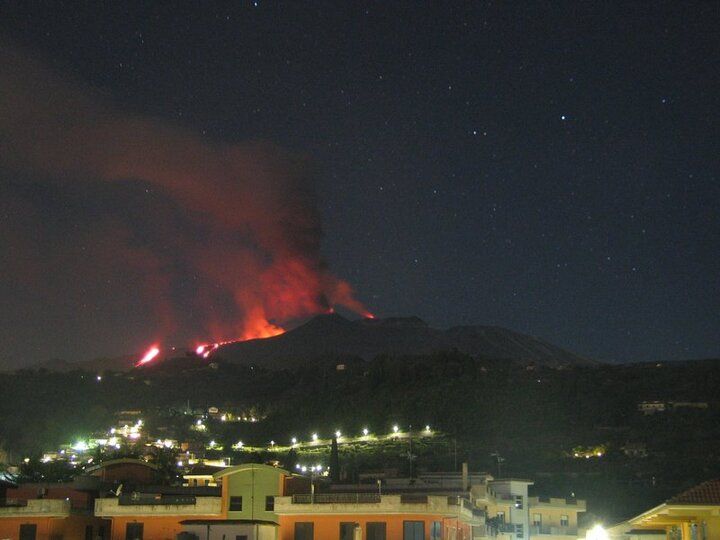
Etna's lava flows descending into Valle del Bove; strombolian activity from the New SE cone (c) and strong glow from Voragine summit crater (r) (image: Osservatorio Meteorologico Nunziata webcam, view from E)

Current tremor amplitude (ESLN station / INGV Catania)
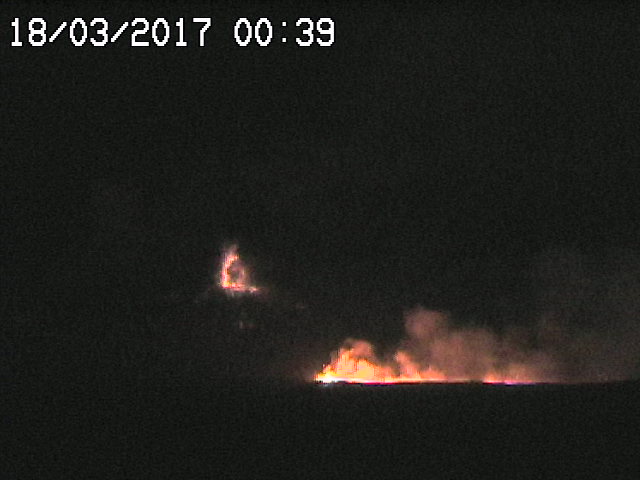
Strombolian activity at the New SE cone and the new lava flow from the fissure at its base (Radiostudio 7 webcam from Montagnola, view from S)
The explosive-effusive eruption continues strongly. Several well-alimented lava flows are descending into the Valle del Bove from elevations between 2500-2700 m at the rim.
At the New SE cone, strombolian explosions or low, pulsating lava fountaining continue.
The latter strombolian-type activity returned to be the dominant activity at the cone shortly before 23:00 local time on Thurday (16 Mar), abruptly replacing the previously intense ash emissions from the same vent. What caused the rapid change in eruption style at this vent is unclear.
During the night 16-17 March, the lava flow from the new fissure vent at the southern base of the SE crater started to descend into the Valle del Bove. The first flow front arrived at the edge of the depression at 23:48 near the Cisternazza pit crater (at about 2600 m elevation) and then quickly descended the steep slope into the Valle, reaching the ridge (formed by dykes) of the Sierra Giannicola Grande shortly before 2am (17 Mar).
A bit later, small glowing rockfalls began to descend into the Valle from points higher upslope, near the Beledere zone (2700 m elevation), originating from the sides of a branch of the lava flowing more or less parallel to the edge of the Valle.
This situation continued all day during yesterday (17 Mar). At around 22:30 in the evening, two tongues of the lava flow also started to descend into the Valle del Bove from the Belvedere area.
As of 02 am local time (18 March), the activity continues with little signs of waning and the lava flows (currently 3 branches actively descending into the Valle del Bove) remain well alimented. Tremor levels although lower than during the first 24 hours of the eruptive phase have more or less stabilized at elevated levels.
Dense ash emissions from SE crater cone

Ash emissions from Etna's SE crater cone (image: Nicola Zappala webcam from Bronte)

Satellite image of Etna on 16 March 2017 (image: SENTINEL 2 - ESA/Copernicus; annotations: Culture Volcan)
The explosive-effusive activity continued during the whole day, but an interesting change occurred at the upper vent (the "New SE cone"): from about 14:30 local time, the strombolian activity (or pulsating low lava fountaining) there changed into and then alternated with dense ash emissions.
The ash plume rose a few 100s of meters and drifted SW towards Adriano.
In the meanwhile, the first lava flow (from the upper southern flank of the SE crater) stopped and ceased to be alimented, while the second flow that had appeared late on 15 March originating from a new fissure vent at the southern base of the cone continued to advance and reached the ramparts of the Valle del Bove.
A satellite image taken today by the SENTINEL 2 and processed by
Culture Volcan shows the scene well, with the second lava flow at that time being about 1400 m long and 250-300 m wide, with its front near or just below 2700 m in the area where the jeep track bends and the phreatic explosions occurred that caused several injuries.
New lava flow from SEC - Phreatic explosion causes injuries
Update Thu 16 Mar 2017 22:19
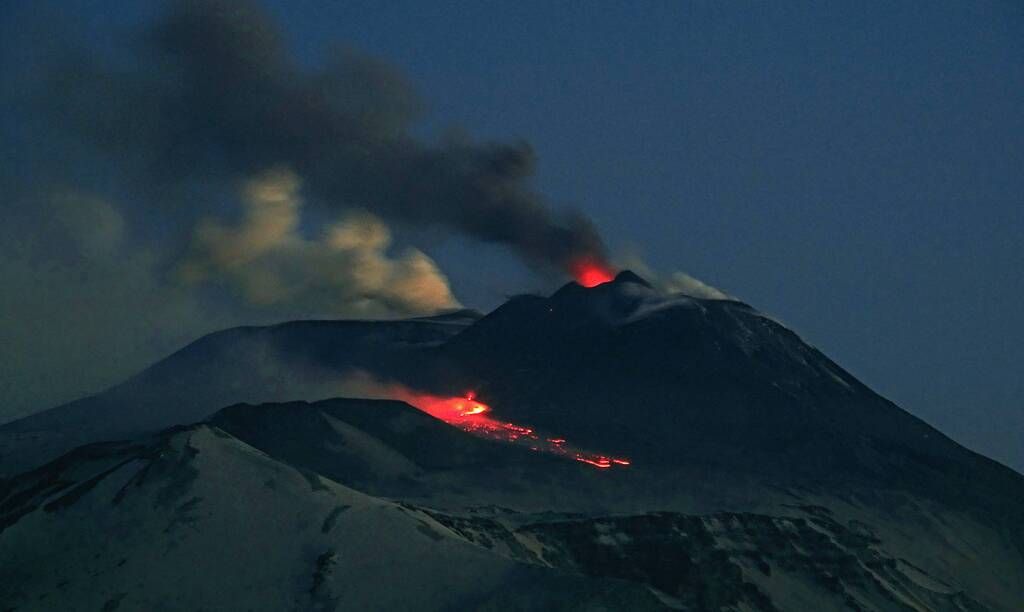
Strombolian activity and lava flow at dawn (image: Boris Behncke / Flickr)
The strong strombolian activity from the SE crater continued all day yesterday and today. The lava flow from the summit vent has flowed on top of the lava flow from about 15 days ago and yesterday it had reached an altitude of 2800m.
Yesterday late in the evening a new lava flow started from a vent that has opened at the southern base of the SE crater. This lava flow descended slowly toward the southeast reaching the Belvedere at an elevation of 2700m.
This morning the contact of the hot lava with snow caused a phreatic explosion, ejecting fragmented rocks in all directions. Unfortunately several tourists, mountain guides and volcanologists were close to the front of the lava flow when this explosion happened. Several people sustained injuries due to falling rocks, but luckily nobody is in a bad condition. Also present was a BBC television crew that has recorded the moment of the explosion.
http://www.bbc.com/news/world-europe-39293086
This afternoon at around 15:00 a dense pulsating ash column started from a summit vent of the SE crater. It is dispersed by the wind in westerly directions.
Tremor is fluctuating, but there's a slow overall descending trend.
New lava flow and strombolian activity at SEC
Update Wed 15 Mar 2017 14:46
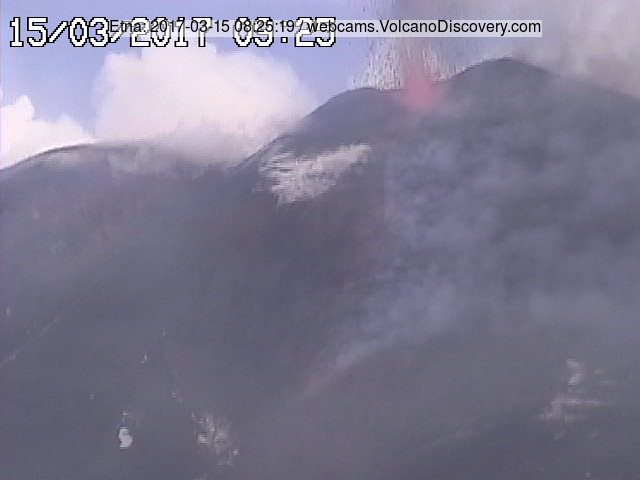
Strombolian activity and lava flow view from Montagnola (Radiostudio7 webcam)

Thermal image of the eruption ( INGV Montagnola thermal webcam)
The weak strombolian activity started a few days ago has slowly increased until this morning, when suddenly the tremor steeply rose. This signaled the arrival of more and stronger explosions at the new vent located between the "old" and "new" SE crater.
The pyroclastic material ejected over the vent has generated a rheomorphic lava flow that has reached the base of the cone. The current pattern is very similar to the last episode which occurred about 15 days ago.
At the moment due to bad weather conditions, the ongoing activity can not be observed but tremor remains stable at slightly elevated levels.
Weak Strombolian activity resumed at SE crater
Update Sun 05 Mar 2017 15:01
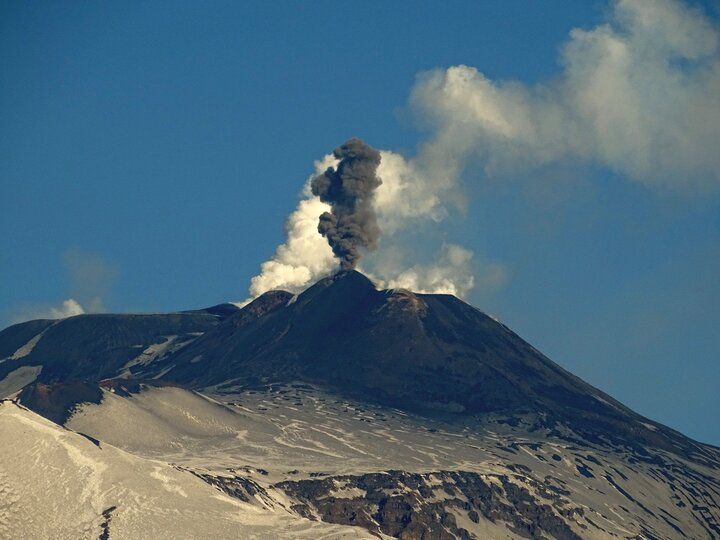
Ash emission on the 3rd of March from the SE crater (image: Boris Behncke / Twitter)
After only a few hours since the last eruption stopped, some sporadic weak ash emissions resumed from the new vent of the SE crater.
Today bad weather prevented detailed observations but during brief moments of visibility it was possible to observe that the weak strombolian activity is still ongoing.
Seismic tremor remains low.
Eruption ends at SE crater, ash emissions from Voragine
Update Thu 02 Mar 2017 17:38

Ash plume from Etna this evening (image: etna-guide webcam)

Current tremor amplitude (SMNR station / INGV Catania)
The first significant eruption of Etna in 2017 ended during last night. What could be called a "subdued" paroxysm from the New SE crater consisted of near-continuous strong strombolian bursts from the saddle vent at the SE crater complex with the effusion of a lava flow that spread at the southern feet of the cone.
After having lasted approx. 48 hours, the intense explosive-effusive activity began to weaken quickly after 22:00 local time yesterday evening and ceased at around 23:30.
During the activity, a new cinder cone has grown significantly at the vent located between the "old" and "New" SE crater.
However, activity has not completely stopped. While the spectacular activity at the SE crater died off, incandescence started to re-appear from the vent in the Voragine summit crater and gradually increased. Intense degassing and ash emissions have taken over from this vent and are currently continuing.
Strong strombolian activity from SE crater and lava flow
Update Tue 28 Feb 2017 19:55
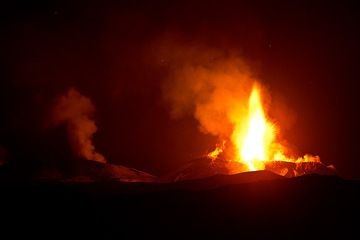
Strmbolian activity and lava flow from Etna's SE crater Photo: Emanuela / VolcanoDiscovery Italia)
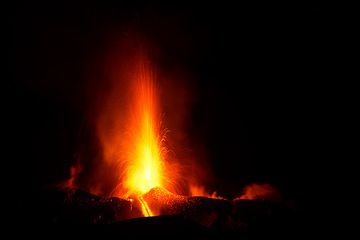
Strmbolian activity and lava flow from Etna's SE crater Photo: Emanuela / VolcanoDiscovery Italia)
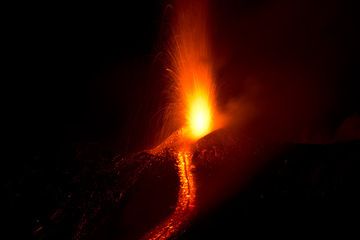
Strmbolian activity and lava flow from Etna's SE crater Photo: Emanuela / VolcanoDiscovery Italia)
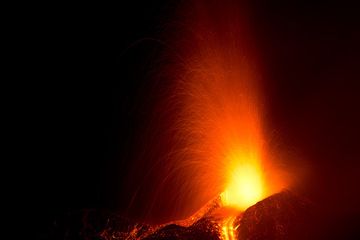
Strmbolian activity and lava flow from Etna's SE crater Photo: Emanuela / VolcanoDiscovery Italia)
After a few months of showing a little activity yesterday Etna erupted again.
At around 18:00 the volcanic tremor sharply increased, signaling the start of large strombolian activity from a new vent that has opened between the old and new cone of the After about half an hour a small lava flow started from this new vent.
The direction of the lava flow is towards the southwest and at 11:00 this morning it had flowed down slowly to an elevation of about 2850m ASL.
Ash fall has been reported from villages to the E/NE (Linguaglossa, Zafferana etc). The webcams show that strombolian explosions are still occuring, the lava flow also appears not to have stopped and the tremor remains high.
Some pictures taken during the night:
Strombolian activity at SE crater continues
Update Thu 16 Feb 2017 08:54
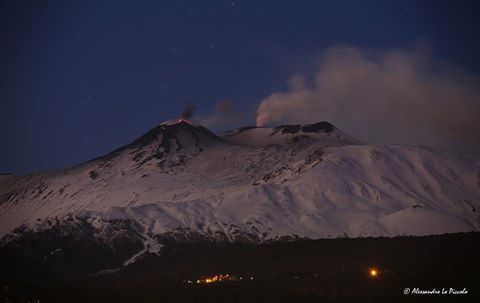
Strombolian activity at Etna's SE crater and glow from Voragine (image: Alessandro Lo Piccolo / facebook)
The volcano remains restless with little changes in activity during the past weeks.
The mild to sometimes moderate strombolian activity continues to occur from the "saddle vent" between the old and new SE crater, at fluctuating levels during the past weeks.
In addition, glow is visible from Voragine summit crater, accompanied by strong degassing. Whether the current mild eruptive activity will eventually increase towards a paroxysm or something else (e.g. gradually dies down again) remains to be seen.
Strombolian activity at SE crater continues
Update Fri 27 Jan 2017 19:58

Strombolian eruption at Etna's saddle vent this morning (image: Boris Behncke / flickr)
The strombolian activity from the saddle vent between the old and new SE crater continues.
Strombolian activity from New SE crater
Update Tue 24 Jan 2017 21:48
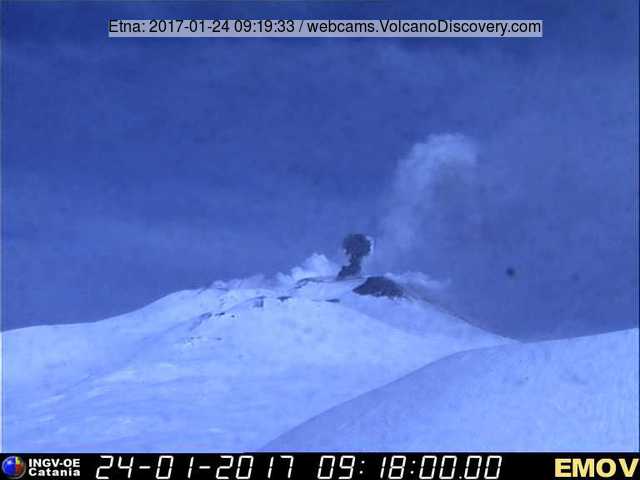
Ash emissions from Etna's SE crater (Montagnola webcam, INGV Catania)
A long period of bad weather conditions prevented direct observation of Etna's summit over the past weeks. Nonetheless during brief moments of visibility a faint glow from the Voragine could be observed, together with discontinuous ash emissions from the South East Crater.
Since last night weak strombolian activity from the South East Crater has started and this has intensified during the day.
Additionally, on the 19th of January there have been four seismic events at shallow depths on the Pernicana fault in the NE flank of the volcano.
Occasional small ash emissions from SE crater
Update Thu 29 Dec 2016 19:05
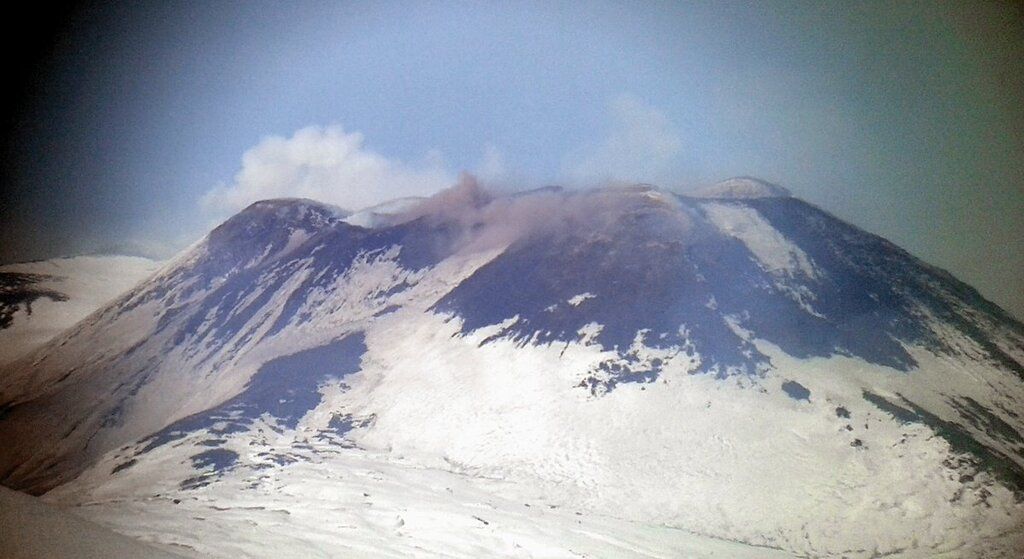
Ash emissions from Etna's SE crater on 25 Dec 2016 (image: Boris Behncke / @etnaboris / twitter)
Small ash emission continue to occur sporadically from the "saddle vent" at the volcano's SE crater.
Ash emissions from SE crater
Update Fri 23 Dec 2016 09:11

Ash venting from Etna's SE crater (image: INGV Catania via B. Behncke / facebook)
After several days of very bad weather, Etna is again free of clouds. This morning, the "saddle vent" of Etna's Southeast Crater (between the old and new SE crater) could be seen emitting small ash plumes.
Tremor is currently low.
Signs of unrest increase
Update Sun 11 Dec 2016 18:50
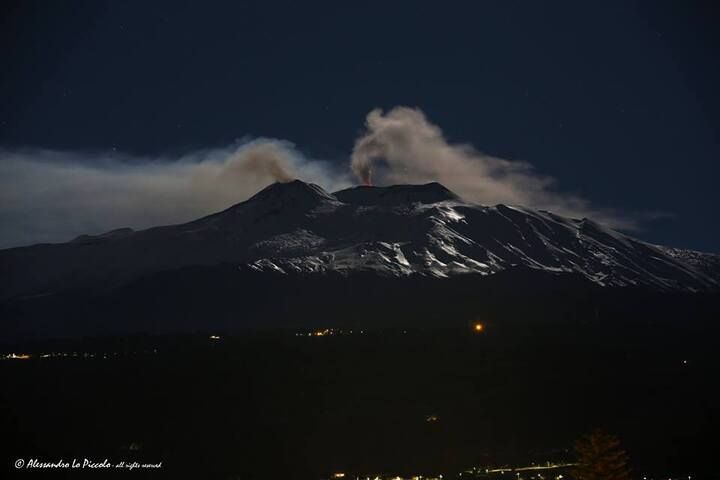
Glow from Etna's Voragine crater yesterday night (image: Alessandro Lo Piccolo / facebook)
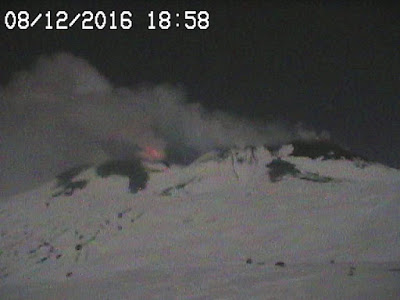
Glow from Voragine on 8 Dec

Current tremor amplitude (ESLN station / INGV Catania)
The volcano is showing signs of becoming more active again: Over the past few weeks, emissions of gas, steam and sometimes perhaps some dilute ash from the main vent in the Voragine summit crater have increased. In addition, intermittent weak glow can be detected from the same vent at night. This, too seems to have been becoming stronger and more frequent recently.
Etna will be interesting to follow in the coming weeks or months for sure.
Otherwise, no significant events have occurred since the Bocca Nuova explosion on 10 Oct and the subsequent (or contemporary) collapse of this crater's floor by about 50 m.
Tremor shows a very faint upward trend, but it is not a clear indication (yet). The large peak on the tremor diagram is the shaking caused by the passage of seismic waves from the recent
magnitude 8 earthquake in the Solomon Islands, and has nothing to do with nor affected Etna.
Bocca Nuova crater floor collapses
Update Tue 11 Oct 2016 21:14
Etna mountain guide Marco Ponte reported that "the whole" of the Bocca Nuova crater has collapsed (subsided) by 50-70 meters since yesterday's explosion.
Volcanic tremor is showing a weak, but increasing trend, suggesting that something is happening at the volcano and could result in surface activity in a near future. What is coming next at Etna is currently pure speculation.

Current tremor amplitude (ESLN station / INGV Catania)
Explosion at Bocca Nuova
Update Mon 10 Oct 2016 18:42
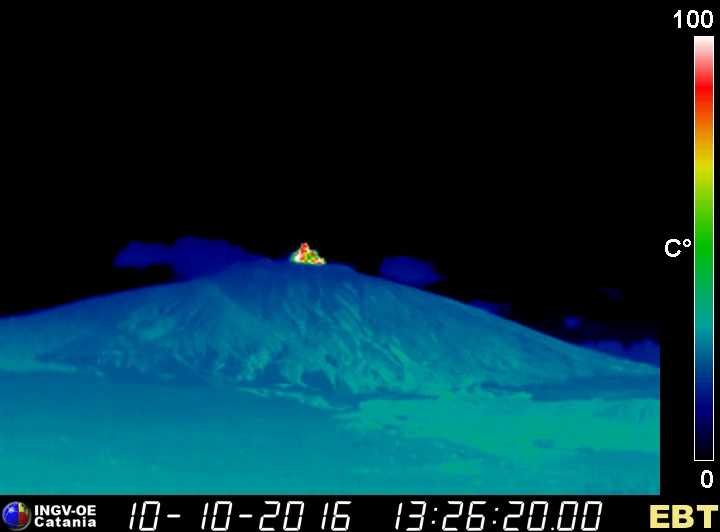
Thermal image (view from Bronte) of the explosion at Bocca Nuova crater (INGV Catania)

Same image a bit later showing the ash plume
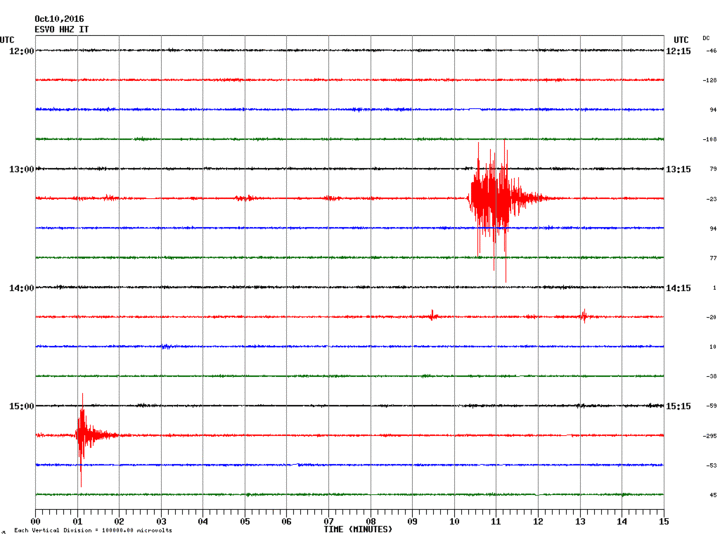
Seismic signal (ESVO station, INGV Catania)
While on excursion in the summit area of Etna today, our guides felt an earthquake at noon. At 15:26, a sudden explosion occurred from the Bocca Nuova crater (the westernmost of the summit vents).
Currently, the nature of the event (phreatic explosion?) is unknown. The thermal webcam from the western side shows an ash plume of a few hundred meters height and a weak hot spot caused by the event.
View of the central summit crater
Update Sat 08 Oct 2016 15:42
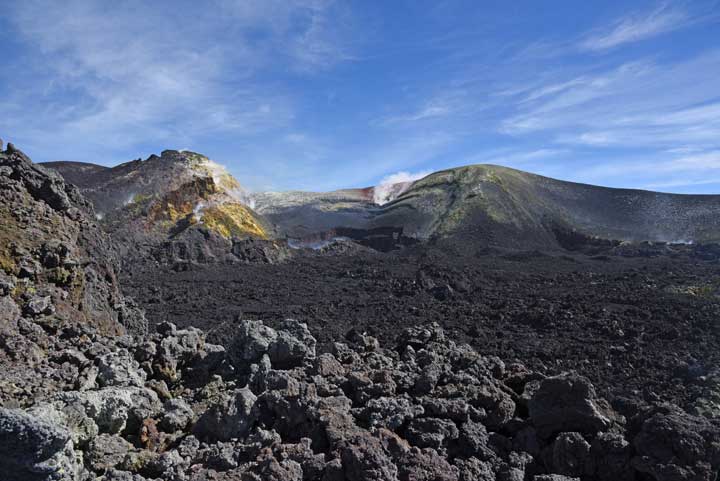
VIew of Etna's Bocca Nuova (foreground) and Voragine behind
The volcano has remained calm, at least on the surface, during the past weeks. During a visit of the summit region this morning, we had a fine view of the central crater complex (Bocca Nuova and Voragine), completely filled by the lava erupted during the paroxysm in May 2016.
Degassing from circular fractures around the main vent in Voragine crater, the New SE crater and NE crater are at normal (intense) levels.
Activity decreases
Update Mon 29 Aug 2016 09:04
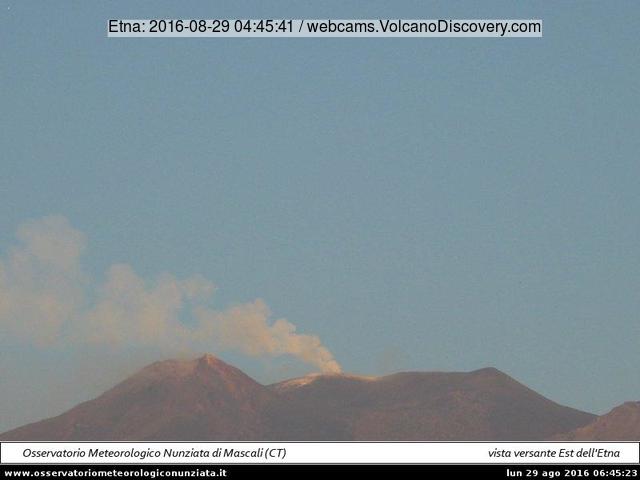
Steam/ash plume from Etna's Voragine this morning

Ash emission from the New SE crater on Friday
Over the past weeks, the volcano's activity (at Voragine and the New SE crater) has generally decreased and tremor levels are currently low.
While not entirely stopped, the emissions of hot incandescent gasses and ash, along with weak strombolian activity from the new vent in the Voragine crater have become less pronounced. Similarly, the sporadic ash emissions from the New SE, observed intermittently until at least Saturday, have ceased or become even rarer.
This could rapidly change, however.
New glowing pit crater in Voragine
Update Thu 11 Aug 2016 09:28

Etna's new pit crater in Voragine (image taken by B. Behncke from western rim of Voragine on 10 Aug 2016 at sunset)
INGV Catania volcanologist
Boris Behncke visited the summit region of Etna yesterday and observed a new active pit crater, about 20-30 m wide, located in the eastern inner wall of the Voragine crater.
The new vent formed on 7 Aug 2016 and has been the site of the recent weak strombolian activity (which likely continues, but bad weather is currently hiding the view).
Continuing strombolian activity in Voragine
Update Tue 09 Aug 2016 13:23
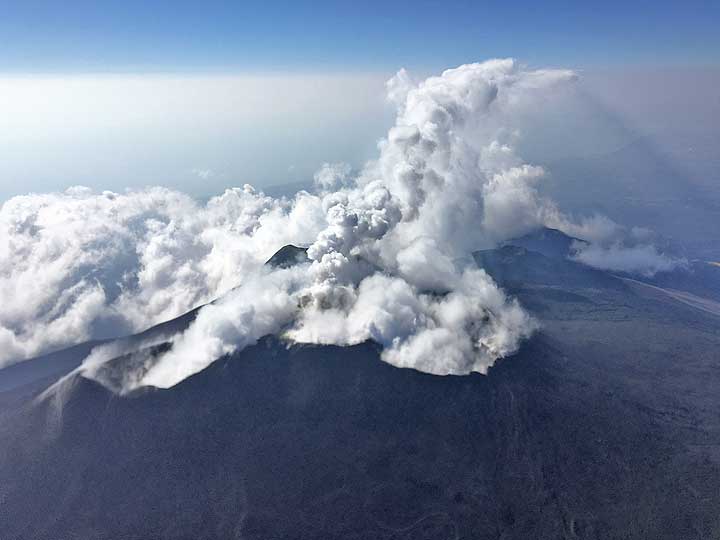
Aerial view of Etna's summit crater with steaming Voragine crater (center) seen from the N (image: Sandro Dimola)
Weak strombolian activity continues inside the Voragine summit crater, which produces a tall steam column currently drifting into southerly directions when we observed it this morning during a helicopter overflight as part of a
tour on Etna.
Tremor remains currently at low levels (but this can change quickly).
Strombolian activity from Voragine crater resumed
Update Sun 07 Aug 2016 21:26
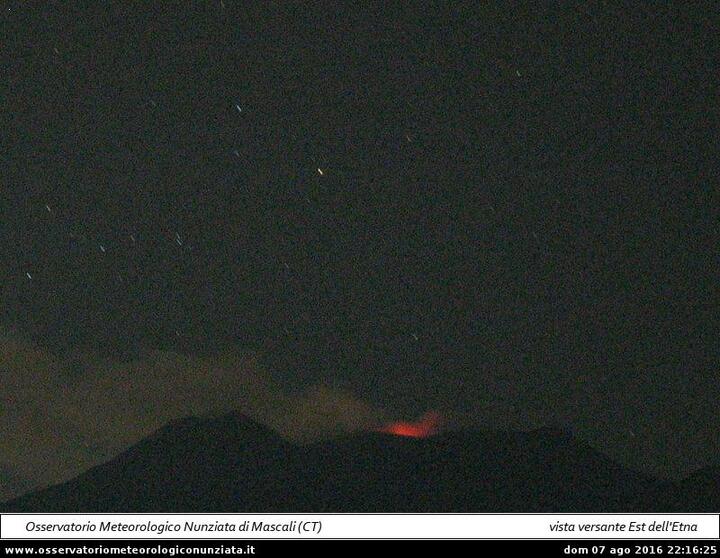
Strombolian activity at the Voragine Crater (Osservatorio Meteorologico Nunziata webcam)
Weak strombolian activity has started from the Voragine crater and it is currently visible from the webcams.
Seismic tremor doesn't show significant changes.
Intermittent ash emissions from New SE crater
Update Fri 05 Aug 2016 07:10
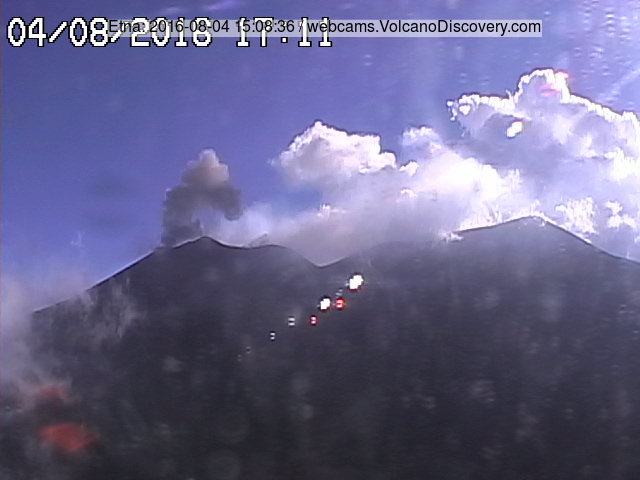
Ash plume from Etna's SE crater yesterday evening (RadioStudio7 webcam)

Current tremor signal (EMFS station / INGV Catania)
Since Wednesday (3 Aug) evening, the New SE crater has been producing intermittent small ash emissions. This activity has become more intense yesterday and seems to have decreased again today.
Weaker and rarer emissions had also occurred during 21-27 July and then again ceased. Thermal imagery shows that the ash is of low temperature only, which probably means that the origin are internal collapses rather than explosions of fresh magma inside the conduit. Volcanic tremor is currently low.
Volcano remains restless, increased gas emissions
Update Thu 21 Jul 2016 07:20
The volcano remains calm at the surface but is restless. Its internal seismic activity continues to be higher than normal and SO2 gas emissions have increased a bit recently (to approx. 7,000 tons/day), which could indicate the influx of fresh magma.
Additionally, occasional small ash puffs, along with pulsating gas emissions, have been observed at the New SE crater since 10 July. These are likely signs of deep-seated explosive activity (degassing from the magma column inside the conduit). Volcanic tremor remains currently stable with no clear trend, but this can change quickly.
Changes of Etna's summit area:
The attached image shows the summit craters as seen on an overflight by volcanologists from INGV Catania on 27 May (
link to original report).
There have been significant morphological changes since the end of the last paroxysms in May. In particular, new fractures have appeared that cross the North-East, Voragine and Bocca Nuova craters from north to south and NW-SE through the SE and New SE cones.
These fractures were caused by extensional stress and define a graben separating NE crater and the Voragine. The NE crater itself suffered from repeated collapses of parts of its rim, generating a pile of debris covering its crater floor now, something that can be seen as an obstruction of its vent (and might lead to sudden violent explosions).
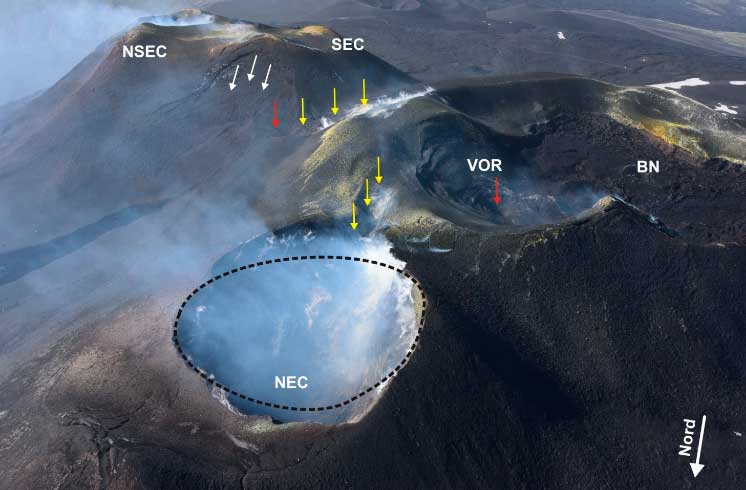
Etna's summit area as seen on 27 May 2016 (image: INGV Catania)
First visit to our site? If you havn't done it yet,
download the Volcanoes & Earthquakes app to get one of the fastest volcano news online:
Android |
IOS















































